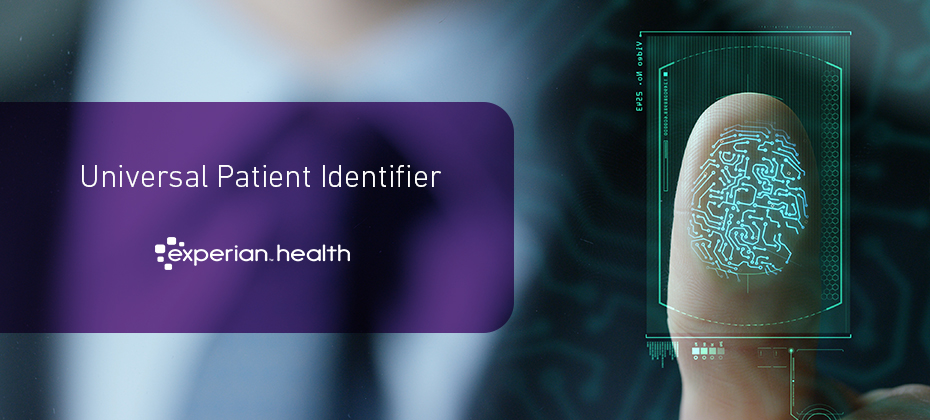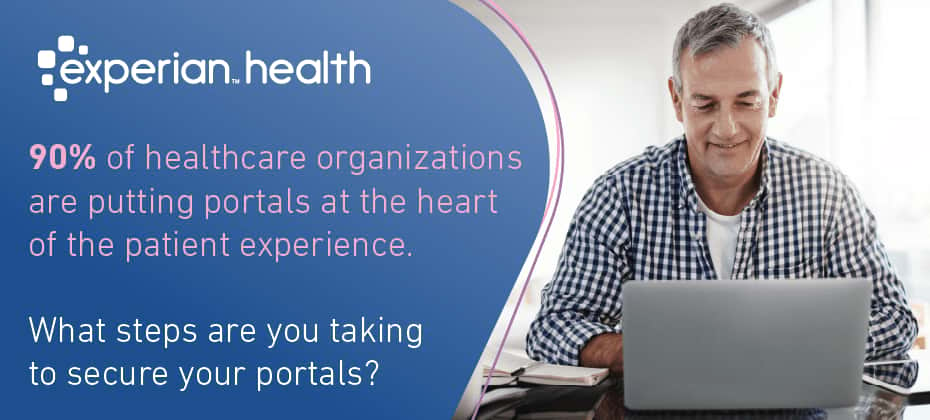Tag: identity management

Providers know they need to improve their digital front door to withstand the financial impact of COVID-19, but change can feel risky, especially with so much uncertainty. Experian Health’s recent patient access survey offers a glimpse of what patients hope the digital front door will look like in 2021 and beyond. But what do providers see for the future of patient access? And are those views aligned? Providers that offer the most accessible patient access solutions in a post-pandemic world will secure greater patient satisfaction and loyalty.

The urgency to move quickly and vaccinate the population has introduced an entirely new set of challenges for providers regarding patient identity. Many continue to leverage existing processes and solutions already in place, manually handling the pain points that come with them, but now at scale and at an unprecedented rate. As the rollout moves forward, the strain on provider resources will only deepen, as will the risks associated with patient misidentification. The data mess behind the scenes Many patients are registering for the vaccine through a patient portal. While the self-service nature of signing up for the vaccine via a portal is beneficial, patients are unfortunately able to register for a portal account more than once. In fact, some of our clients have reported seeing as many as 1,800 duplicate records created per day. Those duplicate records are generated from some individuals who forgot their log-in account information and opted to create a new account, and others who simply forgot they had an account. With the sense of urgency to secure a vaccination appointment, consumers are moving at a rapid speed and simply want to grab a spot with the quickest credentials available. Regardless, multiple registrations for a single patient will create duplicate patient information. Duplicate records are not only costly (the estimated cost of remediation is $96 per duplicate pair), but they are an incredible drain on staff productivity, and ultimately, they are detrimental to patient safety. Multiple records of a single individual pose a risk for potential allergies, reactions, medical history and more. Even more, it is detrimental specifically to the efficacy of the vaccine as it will be harder to gauge in real time how many patients have been vaccinated, and at what stage, and make it more difficult to truly understand what percentage of the patient population has actually been vaccinated. UIM: not another stop-gap solution Experian’s Universal Identity Manager (UIM) platform is tailor-made for a situation like this as it was developed to create a single view of the same patient with their most current information. The matching technology accurately identifies patients and matches records within and across disparate healthcare organizations, providing a more complete understanding of who a patient is, despite the data gaps or errors that may exist in patient rosters. With it, providers are not only preventing duplicate and overlaid patient records but UIM can also minimize errors and fraud in patient records. It additionally improves staff productivity by decreasing the need for record reconciliation—a benefit likely welcomed by many if they are continuing to see anywhere near 1,800 duplicate records per day. When integrated with a solution like Precise ID, providers can both reconcile duplicate records, and effectively stop them from being created in the first place. By automating the patient portal enrollment process, healthcare organizations can remove the manual processes associated with portal enrollment, optimize critical IT staff resources while securing patient information and support a positive patient experience. State-of-the-art identity proofing, risk-based authentication and knowledge-based questions help providers securely verify each patient’s identity as they enroll for the patient portal. Explore how Experian Health can help resolve and enhance identities as part of the vaccine management process and beyond, not only by resolving duplicate records, but also by enhancing records with the best demographic and social determinants of health data available.

Editor's note: This blog post was updated on October 2, 2023. In today's rapidly evolving healthcare landscape, the need for a standardized approach to patient matching and identification has become crucial. Not having a unique patient identifier (UPI) not only poses challenges to managing patient data but also hampers interoperability between healthcare organizations. A unique patient identifier (UPI) is a method for standardizing patient identification. Individuals are assigned a unique code, and that code, rather than a Social Security Number, name, or address, is what is used by healthcare organizations to identify and manage patient information. A standardized code like this not only protects sensitive health information but supports the exchange of data between healthcare organizations and states as it is a number and format easily read and recognized by all. Advocates for a coordinated approach to patient matching are continuing to make the case for a national unique patient identifier (UPI). In April 2023, healthcare organizations wrote to legislators urging them to reject language in the 2024 Health and Human Services appropriations bill that prohibits the use of federal funding for a national UPI standard. More than 150 healthcare and medical organizations signed the letter, including Experian Health. The coalition argues that a standardized approach to patient matching could save lives, avoid medical errors, reduce unnecessary costs and greatly improve operational efficiency. While federal funding currently remains off-limits, the industry is poised to move forward to develop a national patient identity solution that is cost-effective, scalable, secure and one that protects patient privacy. Let's explore how a UPI can revolutionize the healthcare industry and create a truly connected ecosystem. How a unique patient identifier is used in healthcare UPIs give providers and payers a way to link records for the same patient or member, so they have one complete record. Without a UPI, a provider may inadvertently create a duplicate patient record because a slight variation in the patient's name or address means their original record isn't accurately matched to them. A 2022 survey by Patient ID Now found that 6 in 10 healthcare organizations had estimated duplication rates of 4-8%, while 16% of organizations had more than 15 patients with the same name. If there's more than one record for a patient, providers may miss important medical information that's not carried through to the version of the record they're looking at. Unreliable records can also lead to misidentification, where patients with a similar name may have their records incorrectly matched. According to the ECRI Institute, misidentification is one of the top ten threats to patient safety. Patients could be given the wrong treatment or medication, with life-altering or fatal consequences. While patient safety is the top concern for providers, efficiency is another driver of attempts to improve records management. Organizations report spending $1.3 million per year on patient identity resolution, as resources must be redirected to figuring out who patients are and fixing errors. Being able to correctly link records for a complete view of an individual's identity can help circumvent these challenges. A unique patient identifier is the key to interoperability Managing patient data across the entire healthcare ecosystem is a long-standing challenge. Many organizations rely on master patient indexes to match patients using demographic data. But these single-source databases are rife with gaps, overlaps, and outdated patient information. They can't keep up with simple name and address changes or easily identify and fix data entry errors. A more effective solution involves combining data sets to create complete identities and profiles, where every piece of new data is instantly updated and verified. Experian Health uses referential matching technology to achieve a fuller picture of each patient's identity. The UPI then acts as a golden thread, linking each patient record correctly within and between systems. For example, if a provider has a patient in their EHR twice under two spellings of the patient's name, a UPI would link those two profiles, creating a singular view of the patient. If a pharmacy has a patient listed under a birth name but the doctor has them listed under their married name, a UPI can ensure both systems match the patient correctly. When combined with other patient engagement solutions, data and identity management tools create the infrastructure needed for healthcare to truly become one cohesive, patient- and member-centric network. It is important to note that the UPI is not a patient-facing number and is not known to the patient or provider. It does not collect or share any clinical claims or diagnostic information; its purpose is simply to link records together giving providers and payers a complete view of someone's identity. Improving the patient experience with a unique patient identifier Healthcare consumers are increasingly seeking digital-first, efficient processes, and they're sensitive to the need for robust data security. Healthcare organizations must demonstrate their ability to manage patient data properly from the patient's first interaction. If data management is inefficient, patients will find themselves being forced to fill out forms they've already filled out multiple times or undergo duplicate tests as they travel between facilities. Patients with similar names may be confused if they're shown someone else's details during the identification process. In an ecosystem built around a strong healthcare network, these discrepancies can be avoided. The patient's unique identifier remains consistent across every healthcare facility they visit – including physicians' offices, hospitals, pharmacies, specialists and long-term care facilities – so all providers know exactly who they are. While patients welcome a more convenient, coordinated experience, they'll also be reassured by the reduced risk of medical errors that comes with a well-connected healthcare network. Efforts to improve patient identity resolution in healthcare While there may not be a national UPI yet, the industry is trying to find workaround solutions. The Centers for Medicare & Medicaid replaced Social Security Numbers with Medicare Beneficiary Numbers as the primary means of identifying Medicare beneficiaries. But while this addresses the risk of data breaches, it doesn't resolve the interoperability challenge. Another initiative is Project US@ (Project USA), run by the Office of the National Coordinator for Health Information Technology (ONC). This aims to create a consistent healthcare industry-wide specification for representing patient addresses, to improve address accuracy. This would ensure that, for example, the same street name written as “road” and “Rd.” is not mistakenly viewed as two different addresses by the software. To support efforts to integrate disparate software solutions, Experian Health announced in 2019 that every person in the United States had successfully been assigned a unique UPI, powered by Experian Health Universal Identity Manager (UIM) and NCPDP Standards™ (the “UPI”). Combining Experian's expansive data assets and innovative UIM technology along with NCPDP standards, each person who has received medical care or used a pharmacy has been assigned a UPI. As new patients enter the healthcare ecosystem, this number will continue to grow. Dave Roberts, VP of Platform Products at Experian Health, says that “the technological foundation is already in place for data interoperability through the creation of UPIs that are maintained in a master person index. These solutions are vendor-neutral, meaning data can flow freely between disparate electronic health systems, regardless of size or location.” Utilizing Experian Health's Patient Identity Solutions The implementation of unique patient identifiers holds immense potential for creating a connected healthcare ecosystem. By standardizing patient identification and enhancing data management, a unique patient identifier can improve patient safety, reduce costs, and streamline processes across the entire healthcare industry. Find out more about how Experian Health's patient identity solutions serve as stepping stones towards a more efficient and patient-centric healthcare network.

Health plans have been fighting against inaccurate member data, incomplete member profiles and duplicate records for years. Without a watertight way to keep track of patient identities so health data is reliably linked and accessible across multiple services, payers can’t always be confident that the record in front of them matches the member they have in mind. The pandemic has brought this into sharp focus: positive COVID-19 test results aren’t always following members from service to service, and as the vaccination program rolls out, knowing who has had the disease and who has been vaccinated could be difficult to monitor. As health data expands exponentially and the need to share and connect member records becomes more urgent and complicated, the challenges facing health plans will only grow. Could a unique patient identifier (UPI) be the answer? 4 member matching challenges that health plans could solve with a UPI 1. The healthcare ecosystem lacks 21st Century Cures Act data coordination The lack of integrated systems to transfer member data securely contributes to safety issues, payment delays and potential audits and fines. Over a third of denied claims for health systems result from inaccurate patient information, costing them at least $6 billion per year. While this would seem not to impact the payer, the inability to properly link claims to members could lead to an inability to understand the risk represented by the members being covered. Or worse, an inability to anticipate and monitor trends in members health and provide proactive healthcare options. A unique patient identifier can connect the dots between different parts of the healthcare ecosystem so duplicate and incomplete member data can be detected and eliminated. With a more complete picture of who a member is, health plans can make decisions based on accurate information and exchange data safely and securely. There’s a far lower risk of acting without knowing about recent treatment or test results, or communicating using the wrong address (or even to the wrong member). 2. Healthcare providers have outgrown traditional matching tools With the volume and variability of health data to be matched, traditional matching tools are no longer fit for purpose. For example, an enterprise master patient index (EMPI), which links all versions of a patient’s record across several facilities, may seem reliable. However, by relying on a single source of demographic data, EMPIs likely replicate errors and outdated information, and may combine records for patients who share certain demographic information (for example, if two patients have similar names and the same date of birth). Instead, payers should consider a matching solution that combines member roster information with comprehensive third-party reference data. Member records are matched using referential and probabilistic matching, and connected using a UPI. This gives health plans a more complete picture of their members, built on reliable health, credit, and consumer data sources, and allows all parties to understand the person at the center of it all. 3. Discrepancies in member data make care coordination impossible Members may use different names or nicknames, their address may change, and they may even share a Social Security Number (SSN) with someone else. How can health plans help to coordinate care if they’re not sure they’re tracking the right member? A single electronic health record (EHR) can follow the member throughout their healthcare journey with a UPI, so health plans can be confident that the person on the phone or in the office matches the record on screen. They can monitor and respond to gaps in care, allowing them to better coordinate care for better patient health, improved member engagement and money-saving operational efficiencies. 4. Members present to multiple facilities, inhibiting care plan tracking How can health plans reliably track medication adherence, especially when members present to multiple locations? Is there really a gap in care, or did the member just attend a different facility? And if members go to different pharmacies, how can a pharmacist be sure the prescription is going to the right person? All of this can create risks to patient safety and increased costs for payers. A UPI can help. Experian Health has teamed up with the National Council for Prescription Drug Programs (NCPDP), which sets standards for pharmacy services to exchange electronic healthcare data. A framework has been built for a UPI-based patient matching solution that the entire US healthcare network can use. Not only will this improve patient safety, it’ll minimize staff time spent on reconciling incorrect records, thus boosting financial performance too. When it comes to mismatched records, prevention is better than cure. With a Universal Identity Manager, health plans can have confidence in the accuracy and security of the data they’re using and sharing, promote patient safety, and improve staff productivity. Contact us to learn more.

Experian Health products referenced in this blog post: Patient Engagement Solutions Patient Scheduling Precise ID Patient Payment Estimates Patient Payment Solutions To access more insights and trends, download the entire white paper: How has the pandemic affected consumer attitudes toward patient access? What kind of digital experience do consumers expect from their healthcare provider in 2021? Are patients and providers on the same page when it comes to self-service in the healthcare journey? Providers must answer these questions if they are to improve their digital front door, boost patient loyalty and withstand the financial impact of COVID-19. While we know that a satisfying patient access experience translates to a stronger revenue cycle, change can feel risky without knowing what consumers really want. Experian Health surveyed hundreds of healthcare consumers and providers to find out what each expects from patient access in 2021, and uncovered opportunities for providers to lay the groundwork for future financial success. Survey findings: 4 revenue-boosting opportunities for patient access in 2021 1. More control and convenience for consumers Nearly eight in ten consumer survey respondents want to be able to schedule their own appointments, at any time of day or night, from their home or mobile device. They can already order groceries and view their bank accounts this way – and they want the same level of control and convenience when managing the non-clinical aspects of their healthcare. Digital patient engagement solutions allow providers to offer consumers the flexibility and accessibility they crave. Patients can schedule appointments online, complete registration from home and pay bills from a mobile device. Convenience also delivers health benefits: no-shows are less likely, and patients find it easier to adhere to care plans. And while COVID-19 remains a concern, self-service options minimize face-to-face contact, keeping staff and patients safe. Automating patient access even contributes to better collection rates, for example, by reducing errors that can lead to denied claims. 2. But don’t deliver convenience at the expense of safety and security Patients want convenience, but they also want their data to be kept safe. More than half of consumers surveyed, particularly the younger age groups, say they worry about security when accessing their personal details online. Security can be challenging for providers: they need multi-layered solutions that can adapt to security threats that evolve with ever-increasing complexity, without creating cumbersome log-in processes for patients. But with the right technology, providers can safeguard patient data with confidence. Experian Health’s patient portal security tools use leading-edge identity proofing, risk-based authentication and knowledge-based questions to reliably verify patient identities. Patients can book appointments, register for care or view their health information. Calls to IT support are likely to drop too, saving staff and patients valuable time. 3. Contactless care requirements are driving long term, systemic change While many of these changes were already simmering in the background, the pandemic has turned up the heat and accelerated the need for contactless care. Will this be a long-term trend? Both patients and providers believe self-service technology is here to stay and seven in ten providers surveyed say they don’t expect patients to feel comfortable in waiting rooms until at least summer 2021. While face-to-face care will always be important, it seems likely that a digital front door will become the default to make the non-clinical portion of the healthcare journey easier and quicker for everyone. “As providers expand the use of patient portals, there is a huge opportunity to demonstrate the true value of virtual care – and transform healthcare for the long-term." - Tom Cox, general manager, head of product, Experian Health 4. The financial conversation between consumers and providers must be based on trust, transparency and empathy When the final bill bears no resemblance to initial estimates, patients feel frustrated and misled. With deductibles and out-of-pocket expenses on the rise, patients are demanding simple and clear pricing information so they can plan accordingly. Providers that offer consumers transparency, understanding, control and convenience when managing their financial responsibilities are going to have the competitive edge. Providers can achieve this with clear, upfront and accurate pricing estimates to help patients understand their financial obligations before their visit. Next, support to check coverage and advice on tailored payment plans will provide patients with as many tools as possible as they plan to meet those obligations. Experian Health’s Patient Payment Solutions can check for patient coverage, identify a payment plan(s) that suits a patient’s individual situation, and then make it easy to pay via a mobile device. Future provider revenue hinges on investment in digital healthcare. A welcoming, convenient and secure digital front door translates to patient loyalty, which in turn can mitigate losses in challenging times. Wherever are in digital patient access journey, there’s an opportunity to improve the experience for patients and build a revenue cycle that not only survives the tumult of the pandemic, but also thrives in the years ahead.

As 2020 draws to a close and headlines hint that the end might finally be in sight for the pandemic, the healthcare industry is considering COVID-19’s legacy. The sudden shift to contactless care, financial consequences of widespread social distancing measures and changing expectations of the patient experience have upended the world of healthcare and health IT – but which changes are here to stay? And what do these changes mean for the patient experience in 2021? We asked several leaders across Experian Health for their predictions in the areas of patient access, collections, and identity management, and here is a preview of what they had to say: “Patients will choose providers that give them control over their healthcare experience” Patients have more opportunity today than ever before to manage their healthcare experience from the comfort of their own home, whether that be through patient portals, online self-scheduling and registration or online payment tools. As lockdowns and social distancing prevented patients from presenting in person, providers were forced to offer patients with more options for self-service. Unsurprisingly, this was a move a lot of patients have been waiting for and many welcomed this new technology with open arms. Jason Kressel, senior vice president of consumer products and analytics at Experian Health, expects that, as patients become more accustomed to this level of self-service, more than half of consumers will change providers in favor of one that offers premium digital healthcare services: “Providers who can meet patients where they are—through web-based services and via their mobile devices—will have the most success with retaining and attracting patients.” Online self-scheduling can put patients in the driver seat while also avoiding unnecessary contact while many remain cautious about on-site visits. With access issues removed, the patient experience will improve, in turn improving health outcomes (and providers’ bottom lines!). “With hospital finances on shaky ground, collections will be a top priority for survival” As COVID-related unemployment leads to an unstable insurance landscape, many providers are worried about maintaining effective collections processes, and they cannot afford to spend time chasing payments. Guarding against uncompensated care and tightening up the collections process will be essential. Automated collections software can help collections teams focus their efforts on patients who are most likely to pay, while also helping patients manage their financial obligations with as little stress as possible. Providers can also quickly determine which patients qualify for financial assistance, helping them get them on the right payment pathway for their circumstance without delay. Not only will this provide a much better patient financial experience, it’ll prevent “lost coverage” and allow providers to collect a larger portion of dollars owed. “The surge in portal usage means providers need to watch out for fraudsters” What does the rapid growth in portal uptake mean for data security? The speedy rollout of telehealth and other digital services has exposed security concerns for many providers, who fear a rise in fraudulent activity in 2021 as cybercriminals sniff out opportunities to steal patient data. To protect patient information and avoid costly reputational damage, providers must adopt more sophisticated identity management solutions. By combining cutting edge identity proofing, risk-based authentication and knowledge-based questions, providers can more easily verify a patient’s identity when they log on to their portal, greatly eliminating the risk of fraud. Interested in learning more about other trends that could affect the patient experience moving forward?

Halloween might be over, but healthcare fraud – or simple input errors – can transform a patient’s identity into something completely different. The negative impacts are potentially far-reaching, haunting both patients and providers. Is the patient standing in front of you really who they say they are? Learn more about Experian Health's identity management solutions and how we can help you match, manage and protect patient data with:

A consumer-first healthcare revolution has been simmering for years. Despite efforts to create more human-friendly services, the industry still lags behind other consumer-centric sectors. Patients want healthcare to be simple, convenient and on-demand, but a persistent lack of coordination, accessibility and affordability leaves many struggling to navigate the healthcare landscape with ease. Is this about to change? Has COVID-19 flipped the switch? The pandemic has prompted people to engage with their own care in a way the industry hasn’t seen before, with a surge in telehealth and virtual care. Infection-control forced much of the patient journey online, while providers were pushed to find new ways to communicate quickly and clearly. Now, those with an eye on the road to post COVID-19 financial recovery are optimizing these digital strategies to meet new consumer expectations and improve patient loyalty. Embracing digital technology and automation throughout the entire patient journey will be key to patient acquisition and retention. Where should providers focus first? 4 consumer-led strategies to keep patients loyal 1. Prioritize convenience across the entire consumer experience Eighty percent of patients would switch providers for convenience factors alone – ranking ‘convenient, easy access’ ahead of insurance coverage and quality of care. Creating a digital experience that gives patients the flexibility and simplicity they desire should be priority number one in any patient loyalty plan. Providers can start by reviewing their digital platforms. Encourage patients to use their patient portal to access information, book appointments and manage their healthcare when appropriate. Telehealth and virtual care solutions can be future-proofed with reliable identity protection, so patients can safely access care from home and not worry about cumbersome log-in procedures. 2. Make patient access…accessible The patient experience shouldn’t begin with time-consuming forms, long waits and error-prone manual intake processes. Rather, providers can make it easy for patients to complete as many tasks as possible BEFORE they set foot in the office by automating patient access. Online patient scheduling lets patients book, cancel and change appointments online – which 77% of patients say is very important. It has the potential to reduce delays and no-shows, and can minimize the administrative burden for provider staff. While patients remain concerned about the risk of infection during COVID-19, providers can ease their concerns by reducing face-to-face contact with online pre-registration. 3. Respond to affordability and pricing pain points One Experian Health study found that the top pain points in the consumer journey center on the financial experience, from shopping for health insurance to understanding medical bills. Patients may be unsure what their insurance covers, whether their deductible has been met and whether they can afford the out-of-pocket costs. By providing clear, upfront pricing information about coverage and financial responsibility, providers can protect their patients from unnecessary surprises and reduce the risk of missed payments. Self-service patient payment tools can simplify the payment process too: patients can settle their bills anytime, anywhere, and get advice on financial assistance and best-fit payment plans. 4. Personalize the patient experience from end to end A one-size-fits-all approach doesn’t cut it anymore. Patients are looking for communications and services tailored to their individual needs. That used to be both technically and logistically impossible, but not anymore. Providers today can use comprehensive data and analytics to personalize the entire healthcare journey, from customer relationship management to patient collections. By combining automation, self-service tools and accurate insights into the patient’s circumstances, providers can help consumers make better decisions about their care and how to pay for it. To ensure data reliability and integrity, providers should consider partnering with a trusted data vendor, who can translate robust, multi-source consumer and financial data into a competitive consumer experience. There is no question that COVID-19 has changed the way we do healthcare, but the industry is perfectly posed to harness the change in consumer behavior and shift towards greater patient engagement. By bringing together a myriad of digital tools, providers can create a healthcare experience that’s convenient, compassionate and in line with consumer expectations. Interested in learning more about how we can help your organization welcome new patients through its digital door, and boost loyalty among existing patients?

They used to be little more than clunky messaging platforms, but today, patient portals are the key to a frictionless digital healthcare experience. Consumers can check their medical records and test results with a few clicks. They can schedule appointments, pay bills and renew prescriptions whenever they want. Shifting patient information to portals also increases staff productivity and smooths out several sticking points in the revenue cycle. And with improvements in engagement and efficiency leading to better health outcomes, no wonder 90% of healthcare organizations are putting portals at the heart of the patient experience. But these benefits aren’t without risks. Privacy and security are big concerns for consumers and organizations alike. Patients want to feel reassured their data is safe, while providers want to avoid any reputation-killing headlines about data breaches. Identification and authentication can’t be too complicated though, or the patient experience will suffer. The safest strategy is to use a risk-based multi-layered approach, including identity proofing, fraud management, device recognition and even biometrics. Different levels of security checks can be applied, depending on the likelihood of the person being an imposter. If the information being accessed is particularly sensitive, or when the log-in information doesn’t quite add up, your system should trigger additional checks, such as identity proofing questions. But what are the right questions to ask? The right questions balance risk, trust and proportionality There’s no point seeking security information that could be easily guessed, obtained through a quick Google search or stolen from a patient’s wallet. You need questions only the true consumer would be able to answer – “out of wallet” questions, or knowledge-based authentication. This means the traditional “mother’s surname” question would not be a great choice, as it’s easily discoverable by potential fraudsters. Better questions might relate to the consumer’s city of birth, first car model, first pet’s name or previous address. Of course, these identifiers could still be obtained by nefarious parties, but when used in combination with other identity proofing tactics, it’s a significantly reduced risk. The sweet spot lies in the difference between the consumer’s ability to answer correctly and that of a potential fraudster. Your questions should also be relevant to the consumer and appropriate to the context. For example, a common out-of-wallet question used by financial institutions is to confirm a recent transaction. This ticks the box for security, as only the true consumer would likely know the answer, but in the context of a healthcare portal it could seem odd and out of place. It might make the patient wary and actually do more harm than good in terms of building trust. Progressive questioning lets you use smart logic to select a range of appropriate, varied questions, rotated over time and layered up for additional checks when a certain threshold of risk is perceived. In this way, the patient experience will be flexible, seamless and reassuring, without the burden of excessive admin. How Sutter Health System used better questions to increase enrollment and reduce help desk contacts With around 1.8 million patients actively enrolled, Sutter Health System wanted to offer easy access to their self-service portal, but without accidentally giving anyone access to someone else’s information. They had no true identity proofing process for patients, which led to cumbersome checks, errors and high numbers of calls to the help desk. Introducing the PreciseID® identity-proofing tool meant the team could authenticate users more quickly and reliably, using knowledge-based questions without an arduous process. Now, patients have just four or five simple questions to answer, which are checked against a robust dataset. An online risk assessment verifies the patient’s device and determines whether additional checks are required, balancing security with convenience. Tom Mitchell, Applications Manager at Sutter Health System Office describes working in partnership with Experian Health to find the right set of questions: “It took about a month to really hone in on the types of questions and the frequency of questions needed to achieve a level of accuracy that would equate to properly identified patients. You need to select what is important to you and Experian will work with you to make sure you ask the right questions.” Not only has this increased the number of positive patient matches, it’s also reduced the number of people trying to contact the help desk with password issues. Tom says: “We’re always trying to reduce the number of contacts to the help desk. Before integrating with self-service enrollment, patients would have to fill out a paper form or call our contact center, in which case a live person would have to go through some validation processes of our own. It was a fairly cumbersome, long process without this piece of validation.” Find out more about how PreciseID could help you ask the right questions for better portal protection.